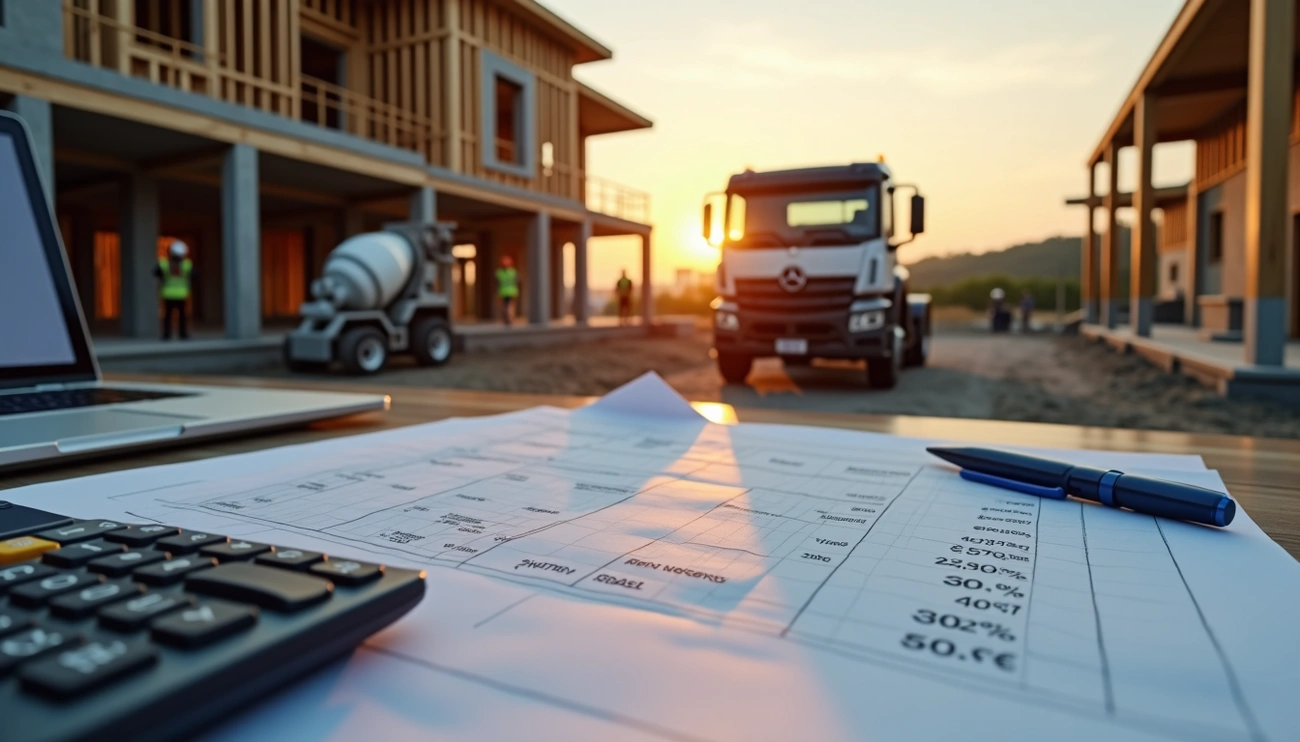Construction loan rates currently range between 6.5% and 9%, significantly higher than what many prospective builders initially expect. If you’re planning to build your dream home in 2025, understanding these rates isn’t just helpful—it’s essential for your financial planning.
When exploring current construction loan interest rates, we’ve found that fixed-rate options typically fall between 7.0% and 8.5%, while adjustable-rate construction loans offer slightly lower rates at 6.5% to 7.9%. Additionally, the average construction loan interest rate as of March 2024 stands at 6.750% for a 15-year term and 7.250% for a 30-year term. However, what banks often don’t mention upfront is that during the construction phase, you’ll only be making interest payments on the funds that have been disbursed to your builder.
In this comprehensive guide, we’ll examine what today’s construction loan rates really mean for your project, why they differ from standard mortgage rates, and the crucial details lenders typically gloss over. By the time you finish reading, you’ll be equipped with the knowledge to navigate construction financing confidently and avoid the common pitfalls that catch many first-time builders off guard.
Understanding Construction Loan Interest Rates
Understanding the fundamentals of construction loan interest rates requires exploring several key factors that make these financial products unique in the lending landscape.
Why are construction loan rates higher than mortgage rates?
Unlike traditional mortgages, construction loans come with inherently greater risk for lenders. Since there’s no existing home to serve as collateral during the building phase, lenders compensate for this uncertainty by charging higher rates—typically exceeding mortgage rates by approximately one percentage point. Furthermore, construction projects often face potential complications such as delays, budget overruns, or unforeseen building challenges that further justify the premium rates. The absence of physical property as collateral throughout the construction period remains the primary driver behind these elevated interest rates.
How today’s construction loan rates are calculated
Several fundamental factors determine construction loan rates in 2025:
- Credit profile: Lenders typically require a minimum credit score of 620, although scores of 740+ secure the best rates
- Economic indicators: The Federal Reserve’s monetary policies directly influence construction financing costs
- Prime rate: This serves as the benchmark for variable interest construction loans
- Loan structure: The loan-to-value ratio and down payment size significantly impact offered rates
- Project details: The scope, location, and builder reputation factor into rate calculations
Inflation also plays a crucial role in shaping construction loan rates. As inflation rises, material and labor costs increase, prompting lenders to adjust rates upward to protect their margins.
What are construction loan rates right now?
As of mid-2025, construction loan rates generally fall between 6.25% and 9.75% APR, depending on your financial situation and project specifics. Fixed-rate construction loans currently average 7.0% to 8.5%, while adjustable-rate options offer slightly lower ranges from 6.0% to 8.0%.
For specific term examples, a 10-year construction loan might start at 6.250% (6.455% APR), a 15-year at 6.375% (6.521% APR), and a 30-year option at around 6.875% (6.966% APR) based on current market conditions. Government-backed construction loans through FHA or VA programs generally offer more favorable rates between 5.5% and 7.0%.
Types of Construction Loans and Their Rate Structures
Each construction loan type comes with its own distinct rate structure and pricing model, serving different needs in the building process.
Construction-to-permanent loan rates
Construction-to-permanent loans combine two financing phases into one product, requiring only a single closing and thereby reducing overall costs. These loans typically start with interest-only payments during construction before converting to a traditional mortgage. Current rates for 30-year construction-to-permanent loans fall between 6.9% and 8.2% in early 2025. Notably, these loans generally require a 20% down payment, which can be substantial—for example, $80,000 on a $400,000 project.
Construction-only loan rates
Sometimes called “stand-alone” or “two-time-close” loans, these finance only the building phase. Construction-only loans feature shorter terms (typically 6-12 months) with interest-only payments during construction. Despite often featuring comparatively lower initial rates than construction-to-permanent options, they ultimately cost more due to requiring two separate closings and loan processes.
Owner-builder loan rates
For those acting as their own general contractor, owner-builder loans present unique opportunities but come with stricter qualification requirements. Rates for 15-year owner-builder mortgages currently start around 6.125% (6.956% APR), 20-year at 6.375% (7.055% APR), and 30-year at 6.625% (7.158% APR). These loans typically demand higher down payments—often 35% of the total project cost.
Government-backed loan rates (FHA, VA)
Government programs offer attractive alternatives for qualifying borrowers. VA construction loan rates presently range from 6.0% to 7.25%, providing favorable terms for veterans. Likewise, FHA construction-to-permanent loans combine land purchase and building costs into a single loan with current rates averaging around 6.24%. Both options typically require less rigorous qualification standards than conventional loans.
Residential vs. commercial construction loan rates
Residential construction loan rates primarily hover between 6.7% and 8.8% in 2025. In contrast, commercial construction financing commands higher rates—commonly 7.5% to over 10%. This rate difference stems from commercial projects carrying greater perceived risk, demanding more documentation, and typically involving larger loan amounts ranging from $250,000 to $5 million.
What Affects Your Construction Loan Rate
Several critical factors determine your construction loan rate, markedly affecting your financing costs throughout the building process.
Credit score and financial profile
Your creditworthiness significantly impacts construction loan approval and rates. Most lenders require a minimum score of 680, with some demanding 720 or higher. Having a credit score above 720 typically secures better terms and lower interest rates. Equally important is maintaining a debt-to-income ratio below 43%, as lenders view this as an indicator of your ability to manage additional debt.
Down payment size and loan-to-value ratio
Traditionally, construction loans required 20-30% down payments. Nowadays, commercial projects often demand 45-50% equity investment. This increased requirement stems from lenders’ efforts to reduce risk. A lower loan-to-value (LTV) ratio—calculated by dividing the loan amount by the appraised property value—frequently results in more favorable interest rates.
Builder reputation and project scope
Following numerous builder insolvencies, 82% of lenders have intensified their due diligence on builders. Lenders increasingly consider contractors’ track records, financial stability, and project management capabilities. Complex projects naturally carry higher risk assessments, potentially resulting in rate premiums.
Location and regional rate trends
Properties in economically stable regions typically secure better rates than versus in economically challenged areas. Regional construction costs, labor availability, and market dynamics all influence lender risk assessments.
Loan term and draw schedule
Shorter-term loans sometimes offer lower rates but require higher monthly payments. The draw schedule—outlining fund disbursement timing—affects interest accrual, as you only pay interest on disbursed amounts.
What Banks Don’t Tell You About Construction Loan Rates
When securing construction financing, many lenders gloss over crucial details about their rate structures. Recognizing these hidden aspects will protect your financial interests throughout the building process.
Hidden fees and rate lock conditions
Beyond the advertised rate, construction loans often include undisclosed charges that inflate your actual costs. These typically include origination fees (0.5%-1% of loan amount), inspection fees ($150-$350 per inspection), and document preparation fees ($200-$500). Moreover, rate locks usually expire after 60 days, potentially exposing you to higher rates if construction delays occur.
Prepayment penalties and refinancing traps
Approximately 70% of construction loans include prepayment penalties during the first 3-5 years. These penalties typically range from 1-3% of the prepaid amount. Additionally, refinancing from a construction-only loan often triggers hidden conversion fees averaging $1,200-$1,800.
How rate adjustments work during construction
For variable-rate construction loans, rate adjustments frequently occur at predetermined intervals (typically quarterly). Each 0.25% increase adds approximately $250 annually per $100,000 borrowed. Consequently, your final interest costs may substantially exceed initial projections.
Why advertised rates may not apply to you
Lenders typically reserve their lowest advertised rates for borrowers with 740+ credit scores, 30%+ down payments, and debt-to-income ratios below 36%. In reality, only about 15% of construction loan applicants qualify for these promotional rates.
Conclusion
Navigating construction loan rates requires thorough research and careful consideration before signing any agreement. Throughout this guide, we’ve seen how these specialized loans command higher interest rates than traditional mortgages—primarily due to increased lender risk during the building phase. Fixed-rate options typically range from 7.0% to 8.5%, while adjustable-rate construction loans offer slightly lower initial rates at 6.5% to 7.9%.
Your financial profile significantly impacts the rates you’ll qualify for. Credit scores above 720, substantial down payments, and low debt-to-income ratios remain essential for securing favorable terms. Additionally, your chosen builder’s reputation and project complexity directly influence lender risk assessment and subsequent rate offerings.
Most importantly, banks often withhold critical information about the true cost of construction financing. Hidden fees, restrictive rate lock conditions, and prepayment penalties can substantially increase your overall expenses. Furthermore, advertised rates frequently apply only to borrowers with exceptional financial credentials—a reality facing merely 15% of applicants.
Armed with this knowledge, you can now approach lenders with confidence and ask the right questions. Rather than accepting the first offer, compare several loan options while paying close attention to fee structures and adjustment terms. Though construction loan rates exceed standard mortgage rates, understanding their nuances allows you to minimize costs while building your dream home.
Remember that during construction, you’ll only pay interest on disbursed funds—an advantage that partially offsets higher rates. Therefore, working closely with your builder to maintain the draw schedule can help manage interest expenses effectively. With proper planning and the insights from this guide, you can navigate construction financing confidently and avoid the pitfalls that catch many first-time builders unprepared.

















5 Responses
I’ve recently started a blog, the information you provide on this site has helped me tremendously. Thanks for all of your time & work.
I really appreciate this post. I’ve been looking everywhere for this! Thank goodness I found it on Bing. You’ve made my day! Thank you again!
Great ?V I should certainly pronounce, impressed with your website. I had no trouble navigating through all the tabs as well as related info ended up being truly simple to do to access. I recently found what I hoped for before you know it at all. Quite unusual. Is likely to appreciate it for those who add forums or something, web site theme . a tones way for your customer to communicate. Excellent task..
Very interesting points you have observed, appreciate it for posting.
You have brought up a very good details , thanks for the post.